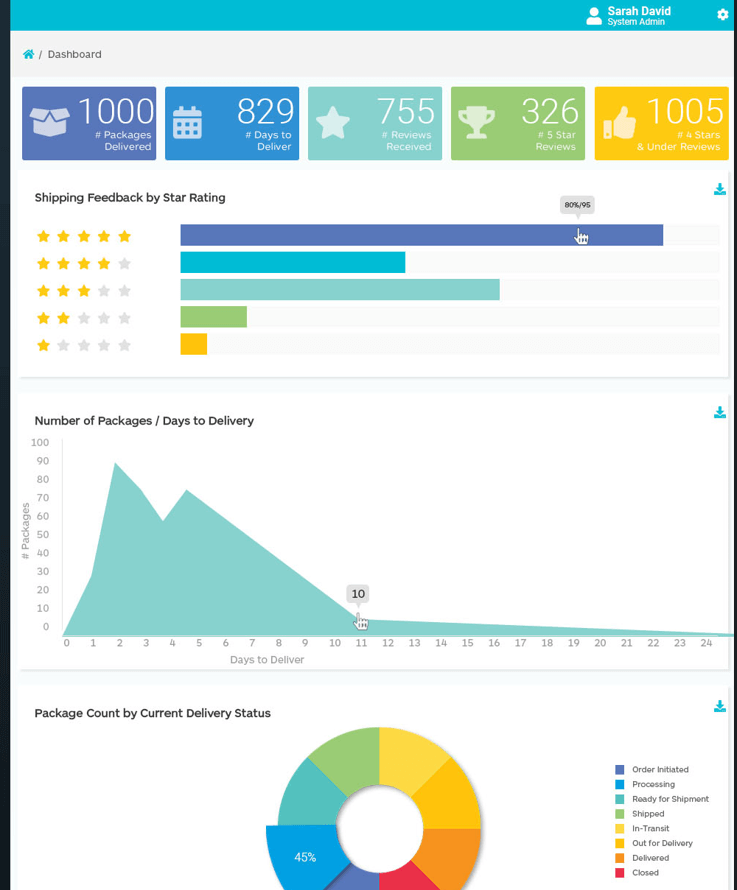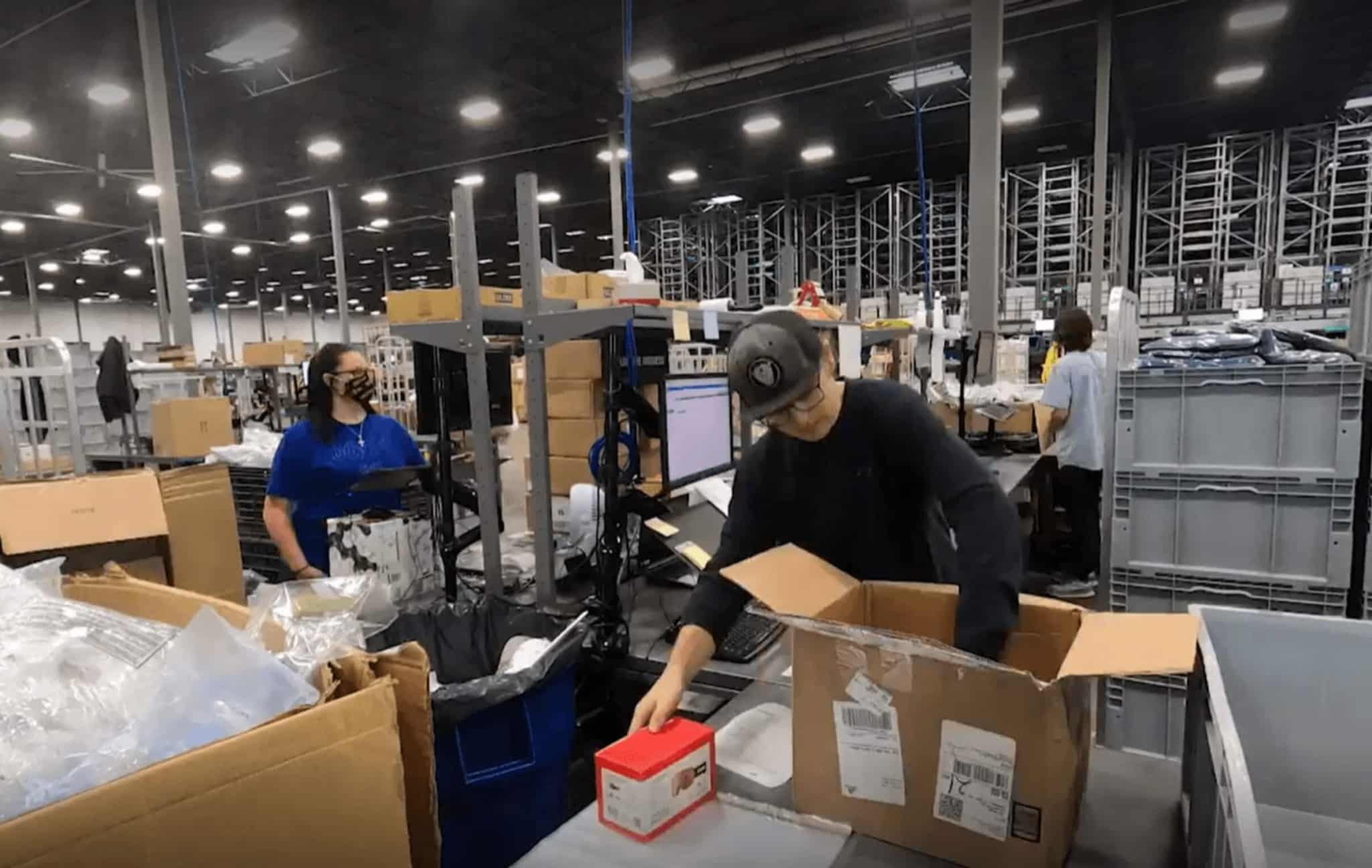WMS vs. RMS for Returns: Pros, Cons, & Which Is Right for You

Product returns are impacting people, profits and the planet. Warehouse workers are scrambling to keep up with the volume of incoming returns; companies are looking for ways to make returns management easier and faster; and leaders are seeking approaches that align with sustainability efforts.
- The average rate of retail returns is 16.5%
- The amount of revenue lost due to returns items is around 10% of total sales
- Up to 30% of B2B sales are returns
Table of Contents for this Article:
- How Supply Chain Software Manages Returns Processes
- Warehouse Management System vs Returns Management System
- Warehouse Management Software Features
- Returns Management Software Features
- Warehouse Management System Benefits
- What are the Disadvantages of a WMS for Returns?
- Returns Management System Benefits
- RMS vs WMS: By Industry
- RMS vs WMS: Comparison Table
How Supply Chain Software Manages Returns Processes
In a ReverseLogix research study conducted with Lead to Market, we found that the majority of respondents manage returns with technology that isn’t purpose-built to handle returns. In fact, 30% are attempting to handle product returns with a warehouse management system while only 6% are using a returns management system.
Let’s take a look at why that’s an important difference.
Warehouse Management System vs. Returns Management System
A warehouse management system (WMS) is an on-premise or cloud-based technology solution that manages the work of a distribution center or warehouse. It supports almost every aspect of the warehouse, including picking, packing and receiving.
However, a WMS solution lacks robust capabilities in returns management.
In contrast, a returns management system (RMS) is purpose-built to manage everything about a product return – from start to finish, from the initial RMA through refund, replacement or credit. An RMS integrates with your existing tech stack, working alongside your WMS, OMS and even TMS to orchestrate every aspect of a return and give you detailed reports and metrics on your returns operations.
To get a better sense of how a WMS and RMS differ for returns management, here’s a closer look at each.
Warehouse Management Software Features
A WMS is a necessary solution for any DC or warehouse in order to effectively manage, track and report on the picking, packing, shipping and receiving activities that take place within its four walls.
Inventory Management
A WMS solution gives users real-time visibility into inventory, offering a centralized and accurate set of data from which warehouse leaders can track inventory, manage productivity, and ensure accurate and fast fulfillment times.
Order Management
Some WMS software offers order management system (OMS) capabilities, such as the ability to track incoming deliveries, update inventory, create and manage pick tickets, manage order entries, and more. However, most larger companies choose to implement a standalone OMS that integrates with their WMS.
Labor Management
A WMS assigns workers specific tasks based on inventory location, and can assign picking based on the most efficient configuration of tasks. Companies can save time and cost because more items are handled more efficiently, with less paperwork, and with fewer touchpoints.
Financial Management and Reporting
WMS software may offer billing systems and financial reporting, or integrate with a suite of financial management and accounting modules.
Risk Management and Forecasting
A WMS’ risk management and forecasting tools help organizations compare prospective and actual revenue. Data and business performance reports can track trends across locations, customers and products.
As the key features above show, a WMS is designed to receive goods and manage related activities. In-depth capabilities around returns management are not key features of a WMS.
Returns Management Software Features
A returns management system (RMS) is purpose-built, cloud-based software that handles product returns from start to finish.
An RMS doesn’t compete with a WMS; rather, it fills a gap that a WMS simply wasn’t designed to address. A WMS is optimized for picking, packing and receiving; an RMS is optimized for managing the processes around returned items.
Here are the key features of an RMS solution.
RMA Management
An RMS is the back-end technology that supports the entire RMA management process.
Return merchandise authorization (RMA) is the first step of a return process. Typically, a customer logs into an online portal and initiates the return process. Your company then validates the purchase and issues a formal approval for accepting the return.
Once the return arrives at the store or warehouse, an employee scans in the return using RMS technology. From there, the RMS uses the RMA number to track the returned item as possible inventory (depending on its condition) and drive fulfillment decisions based on that data.
Customer Portal
An RMS solution offers a customer returns portal that fully reflects your company’s brand, making returns initiation easy and fast. This is also where a customer can go to check the status of their return, exchange, credit or refund.
Business Intelligence
Unlike a WMS, only a returns management system can track and deliver data and insights across the entire return’s journey. An RMS connects directly to all your business intelligence applications and integrates with your tech stack (TMS, OMS, WMS) to deliver powerful business intelligence.
- Identify manufacturing or product issues, update sizing guides, improve product descriptions
- Customize reports for users, roles, locations, products, etc.
- Optimize performance to stay competitive and increase your edge in real-time
- Measure the true cost of product returns with metrics such as cycle time, value from resales, per-item handling costs, and more

Example of ReverseLogix RMS report
Automated Workflows and Communication
Only an RMS can automate returns processes and guide warehouse and/or employees on the policies and rules for managing returns by category, type, or any other features you decide. You can even improve the management of inventory through FSN techniques using an RMS.
This automation standardizes workflows and gives you consistent returns management no matter the store location or warehouse location – and even across your 3PL partners. An RMS delivers automated customer notifications and status updates about the return, helping to reduce service calls and emails.
“ReverseLogix basically gave us the value that having two more rockstar customer specialists would have provided, but it’s all automated and never takes a sick day.”
– ReverseLogix customer, retail sector
Disposition Management
Disposition management could include resale, refurbishing or repair, return to vendor, recycling, or landfilling the item. With an RMS, you can set rules by product category or type, take into account sustainability objectives, and create workflows that guide employees on dispositioning the item.
Warehouse Management System Benefits
As mentioned above, a warehouse management system is optimized for the main processes around picking, packing and receiving – but not for managing product returns.
Keeping that in mind, here are a few WMS benefits for forward logistics.
Optimized Space and Lower Operating Expenses
A WMS solution tracks and knows the location of items, and can optimize how inventory is stored for retrieval, thereby lowering labor expenses.
Inventory Visibility
A WMS tracks how much inventory is sold and replaced, which helps organizations understand how efficiently inventory meets demands.
Effective Labor
With better insight into inventory levels and optimized warehouse placement, employees can be faster and more effective with picking, packing and shipping tasks.
Traceable Materials
A WMS solution tracks and traces your inventory materials, enabling better inventory planning. This also gives you insight into inventory details and volumes in the event of a product recall.
Internal Automation Benefits
A WMS can help with or even dictate tasks and processes so that they are efficient and optimized. This automation makes work easier for employees, more cost-efficient for the company, and gets products to customers in a timelier manner.
Effective Shipment Management providing Better Customer Service
Once an order is received, a WMS with shipping management capabilities can streamline the picking and shipping process. The result: Happier customers with orders that arrive quickly!
Optimized Supply Chain
A WMS is an essential solution for optimizing your supply chain. It automates key warehouse processes, drives faster and more accurate work, and enables your teams to work more accurately and efficiently. It is a must-have for managing the forward logistics of your business
What are the Disadvantages of a WMS?
The main disadvantage of a WMS is that it is not built to handle what comes back to the warehouse as a product return.
- No visibility into the reasons for a product return
- No capabilities for orchestrating return processes and rules across locations, including with 3PL partners
- No comprehensive data that reveals the cost of returns to your organization
- No ability to align sustainability goals with returns decisions and rules
- Poor eCommerce return capabilities
Some WMS solutions can handle pieces of return processes, but that only gives you pieces of returns visibility, efficiency and control. You still have to fill in the gaps with a patchwork of other technologies – none of which give you the centralized, holistic view that a single RMS will deliver.
Returns Management System Benefits
Only an RMS solution fits into your existing supply chain software tech stack and gives you the final piece of the logistics puzzle: A powerful way to anticipate, manage, track and proactively address product returns.
A ReverseLogix customer was told it would take a year to build out returns management capabilities for its Tier 1 WMS platform. They added ReverseLogix to their tech stack and were live with better returns processes in a few months.
Efficiently Receive and Process Returns
In contrast to a WMS that typically requires spreadsheets and manual tracking for returns, an RMS automates the entire process.
From the omnichannel perspective, an RMS can help improve cost-efficiency by directing the customer on where to make the return. For instance, they may start the returns process online and then be directed to the closest brick-and-mortar store to make the return.

Because an RMS powers the customer return portals and data, warehouse workers finally have visibility into how many returns are coming back, to which locations, and in what condition. This way, companies can determine where a return will go and what next steps will be, as well as ensure they have adequate staff to manage return volumes.
“I can plan my manpower for the day or week, because all I need to do is look on ReverseLogix and it’ll tell me how many returns we’re expecting between my two different areas of returns.”
– Erin Johnson, senior returns and vendor compliance manager, Genesco
Error Rates Decrease
Standardized workflows ensure a return is managed and dispositioned the right way, at every location, every time. No more guesswork on what to do with an item!
Returns Trends
Unfortunately, your WMS can’t track return trends and common issues. You won’t get a 360-degree view of returns data in order to address problems proactively or catch issues before they become larger problems. But an RMS will give you valuable insights about return reasons that can be communicated back to your supplier or manufacturer – and address the root cause of the issue.
Revenue Stream for 3PLs
An RMS empowers 3PLs to be a “one-stop shop” for customers’ forward and reverse logistics needs. When a 3PL handles returns services, the items are received at the facility and processed for replacements, refunds, or even recycling and repairs. When 3PLs manage returns for their customers, it takes that task off customers’ plates while giving the 3PL a new way to differentiate itself in the marketplace.
RMS vs WMS by Industry
Here are a few more ways that an RMS is a better choice for managing product returns, no matter the industry.
Retailers and eCommerce Brands
A WMS will require other point solutions and spreadsheets in order to manage product returns for retailers and pure-play eCommerce brands. In contrast, an RMS can help these companies…
- Establish a robust customer returns portal
- Make returns fast and easy for customers. The sooner you can complete the returns process, the less it impacts your bottom line and customer happiness!
- A WMS can’t manage returns well in an omnichannel environment. An RMS offers a returns portal that’s highly configurable, giving you different options whether the goods were purchased online, in a store, or via a third-party marketplace.
Manufacturing
B2B manufacturing customers now expect a B2C shopping and returns experience: fast, easy and flexible. Only an RMS can balance complex return management factors, report on the entire returns lifecycle, and give manufacturers full visibility into the returns process and control over every step.
3PLs
Some 3PLs turn to their WMS for help with the returns services, incorrectly assuming that it can automate returns management the same way it handles forward logistics. But as explained above, a WMS only scratches the surface of the end-to-end returns process.
With a cloud-based RMS, 3PLs can orchestrate every aspect of their customers’ returns, repairs, and after-sales care.
WMS vs RMS: Comparing Solutions for Returns Management
| WMS | RMS | |
| Order management | Yes | Yes |
| RMA management | Limited | Yes |
| Inventory management | Yes | No |
| Customer returns portal | No | Yes |
| Customer communications regarding return status | No | Yes |
| Reporting | Warehouse reporting only – no visibility into returns | Returns reporting (across the lifecycle of the return) |
| Business intelligence | Yes, but not for returns | Actionable intelligence on returns issues, trends, and opportunities |
| Ability to measure returns processing efficiency and labor (units per hour, RMAs by product, etc.) | No | Yes |
| Visibility into incoming returns (RMAs) | No | Yes |
| Direct and automate returns workflows | No | Yes |
| Disposition management | No | Yes |
| Direct rules/policies across locations, vendor networks, etc. | No | Yes |
| Ability to manage eCommerce returns | Limited | Yes, comprehensively |
| Data to determine total cost of returns | Limited | Comprehensive |
| Support for multiple return options (shipping label, QR code, in-store, door pick-up, etc.) | No | Yes |
| Align sustainability goals with returns tasks | No | Yes |
